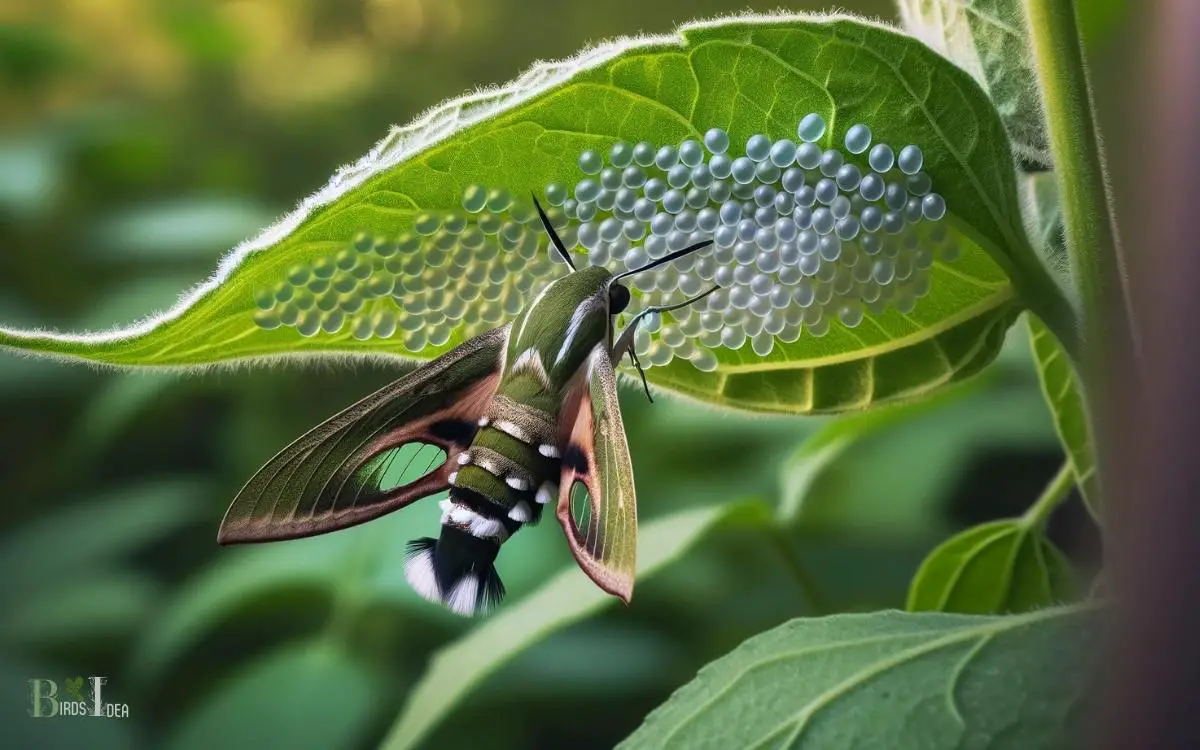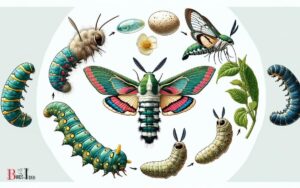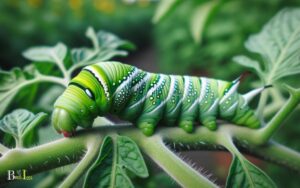Where Do Hummingbird Moths Lay Their Eggs? Find Out!
Hummingbird moths, belonging to the family Sphingidae, typically lay their eggs on the host plants that serve as food for their caterpillars.
These moths are known for their preference for specific plant species, such as honeysuckle, evening primrose, and various types of flowering herbs.
The female moth carefully selects suitable locations on these plants, usually the undersides of leaves, to deposit her eggs.
This choice is crucial for the survival of the emerging larvae, as it provides a readily available food source upon hatching.
The eggs are typically small, spherical, and may be laid singly or in clusters, depending on the species.
The host plants play a vital role in sustaining the life cycle of hummingbird moths, as the caterpillars rely on them for nourishment during their growth and development stages.
Once the eggs hatch, the larvae feed on the plant’s foliage before pupating and eventually transforming into adult moths.

Key Takeaway
Identifying Hummingbird Moths
Hummingbird moths can be identified by their rapid wingbeats and elongated bodies, resembling both hummingbirds and traditional moths.
These insects belong to the Sphingidae family and are commonly referred to as clearwing moths due to their transparent wings.
Their wings can beat at a frequency of around 70-80 times per second, allowing them to hover in front of flowers while feeding on nectar.
Their bodies are typically olive or brown with white or yellow stripes, and they’ve a long proboscis, which they use to extract nectar from flowers.
The combination of these physical characteristics makes them easily distinguishable from other moth species.
Hummingbird moths are often mistaken for actual hummingbirds due to their similar appearance and behavior.
The Life Cycle of Hummingbird Moths
During their life cycle, hummingbird moths undergo a series of distinct stages, including egg, larva, pupa, and adult.
The life cycle of hummingbird moths can be described as follows:
- Egg: The cycle begins with a tiny, translucent egg laid on the underside of leaves or stems, often near the host plants of the larvae.
- Larva: After hatching, the larva, also known as a caterpillar, emerges and begins to feed voraciously on plant leaves, growing rapidly in size.
- Pupa: Once the larval stage is complete, the caterpillar enters the pupal stage, during which it undergoes a remarkable transformation inside a cocoon or chrysalis.
- Adult: Finally, the moth emerges from the pupa, ready to continue the cycle by seeking nectar, finding a mate, and laying eggs for the next generation.
This process continues throughout the life of a hummingbird moth.
Hummingbird Moth Habitat and Behavior
The habitat and behavior of these moths play a crucial role in their life cycle and survival.
Hummingbird moths, also known as hawk moths, are found in various habitats including gardens, meadows, and woodland edges.
They’re particularly attracted to nectar-rich flowers such as honeysuckle, phlox, and bee balm. Their behavior is characterized by their diurnal activity, feeding primarily during the day.
Hummingbird moths are known for their hovering flight, much like that of hummingbirds, and their long proboscis allows them to feed from tubular flowers while in mid-air.
This behavior not only aids in their survival by accessing food sources that other insects can’t reach but also facilitates their role as pollinators.
Understanding their habitat and behavior is essential for conservation efforts and maintaining healthy ecosystems.
Finding Hummingbird Moth Eggs
In suitable locations, hummingbird moths deposit their eggs on the undersides of leaves. When searching for hummingbird moth eggs, one should carefully inspect the undersides of leaves, particularly on plants that are known to attract adult hummingbird moths.
The eggs are typically tiny, round, and translucent, making them challenging to spot with the naked eye. To aid in the search, a magnifying glass can be used to look for the minute eggs.
It’s also helpful to look for signs of feeding damage on the leaves, as the presence of small holes or chewed edges may indicate the presence of hummingbird moth eggs nearby.
Additionally, observing the behavior of adult hummingbird moths, such as their frequent visits to specific plants, can provide clues about potential egg-laying sites.
Egg-Laying Behavior of Hummingbird Moths
When observing the egg-laying behavior of hummingbird moths, one can note their preference for specific types of plants and the meticulous manner in which they deposit their eggs.
Hummingbird moths, also known as hawk moths, primarily prefer to lay their eggs on plants that serve as suitable hosts for their larvae, such as honeysuckle, evening primrose, and various species of honeysuckle.
These moths exhibit a deliberate approach to egg-laying, carefully selecting the underside of leaves or stems as their preferred deposition sites. They often choose plants that provide both food and protection for their developing larvae.
This behavior ensures the survival and development of the eggs into larvae by selecting secure and nourishing locations.
Understanding the intricacies of their egg-laying behavior provides valuable insights into the requirements for successful reproduction and population growth.
This behavior also highlights the critical role of suitable host plants in the life cycle of hummingbird moths.
Suitable Host Plants for Hummingbird Moth Eggs
Hummingbird moths demonstrate a deliberate and meticulous approach to ensuring the survival of their eggs by selecting host plants based on their suitability for larval development.
Suitable host plants for hummingbird moth eggs typically include:
- Honeysuckle: Known for its fragrant and nectar-rich flowers, honeysuckle provides a suitable environment for hummingbird moth eggs to develop.
- Bee balm: With its colorful and nectar-filled blooms, bee balm serves as an ideal host plant for hummingbird moth eggs.
- Phlox: This perennial plant offers a vibrant display of flowers and serves as a suitable host for hummingbird moth eggs to thrive.
- Verbena: With its long-lasting and nectar-rich flowers, verbena provides a suitable environment for the development of hummingbird moth eggs.
These plants not only offer a conducive environment for egg development but also provide a vital food source for the emerging larvae.
Do Hummingbird Moths Lay Their Eggs in the Same Place Where They Spend Winter?
Yes, hummingbird moths do lay their eggs in the same place where hummingbird moths winter. They typically lay their eggs on the underside of leaves, where they will overwinter as pupae. This allows the next generation to emerge in the same location where they spent the winter.
Protecting and Monitoring Hummingbird Moth Eggs
Conservation efforts aimed at protecting and monitoring hummingbird moth eggs are crucial for ensuring the survival of these fascinating insects.
Understanding their nesting and egg-laying habits is essential for creating effective conservation strategies.
Nesting and Egg-Laying Habits
The female hummingbird moths typically lay their eggs singly on the undersides of leaves, choosing locations with an abundance of their larval food plants. This behavior is essential for the survival of the eggs and subsequent larvae.
To effectively protect and monitor hummingbird moth eggs, individuals can employ the following strategies:
- Regular Inspections: Checking the undersides of leaves for eggs on a regular basis.
- Providing Suitable Environment: Ensuring the presence of larval food plants in the vicinity of the chosen nesting area.
- Protection from Predators: Implementing measures to deter potential predators from accessing the egg-laying sites.
- Record-Keeping: Maintaining detailed records of egg-laying locations and monitoring the development of the eggs.
Conservation Efforts and Monitoring
To safeguard hummingbird moth eggs, individuals regularly inspect the undersides of leaves for optimal nesting sites and implement protective measures to deter potential predators.
This involves carefully monitoring the environment and identifying areas where eggs are most likely to be laid, such as on the leaves of host plants like honeysuckle and beebalm.
Conservation efforts also include the protection of these host plants to ensure the availability of suitable egg-laying locations.
Furthermore, the implementation of organic pest control methods helps to maintain a balanced ecosystem without harming the eggs.
Monitoring the population of hummingbird moths and their nesting sites is crucial for understanding trends and potential threats to their survival.
By actively engaging in these conservation efforts and monitoring practices, researchers and enthusiasts can contribute to the preservation of hummingbird moth populations and their eggs.
This proactive approach lays the foundation for caring for hummingbird moth larvae and ensuring their successful development.
Conclusion
Despite their resemblance to hummingbirds, hummingbird moths are fascinating creatures with a unique life cycle and egg-laying behavior.
Their eggs can be found on specific host plants, and monitoring and protecting them can be a rewarding experience for nature enthusiasts.
Remember, if you happen to come across these delicate eggs, handle them with the utmost care and respect – after all, you never know when you might be fostering the next generation of these remarkable moths.






